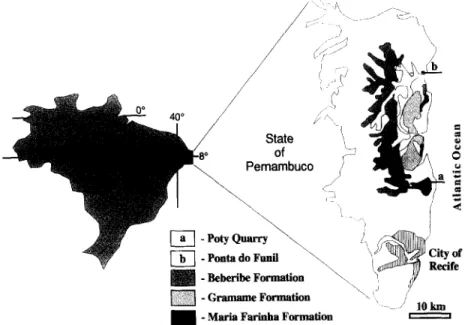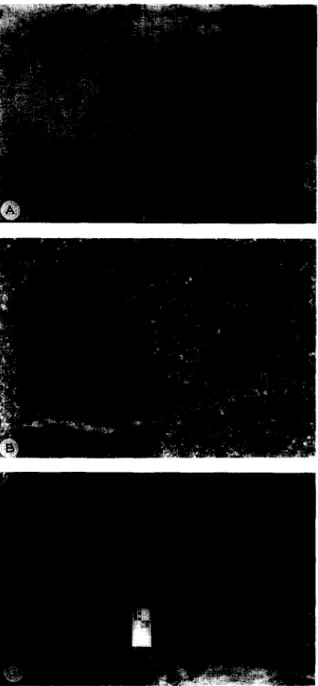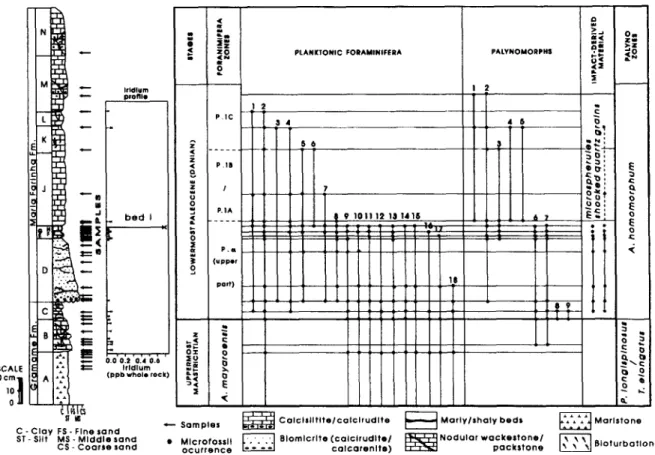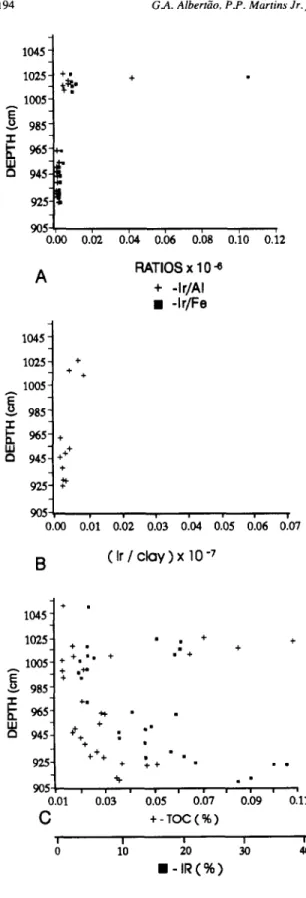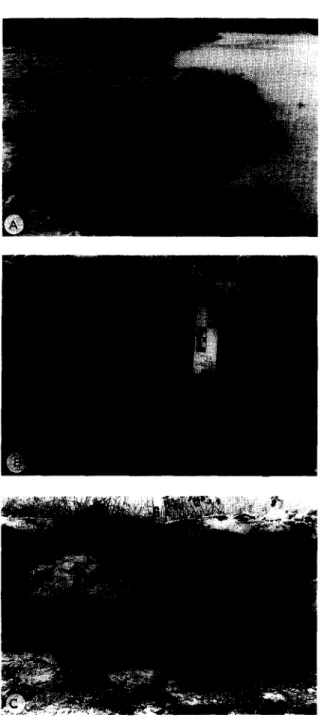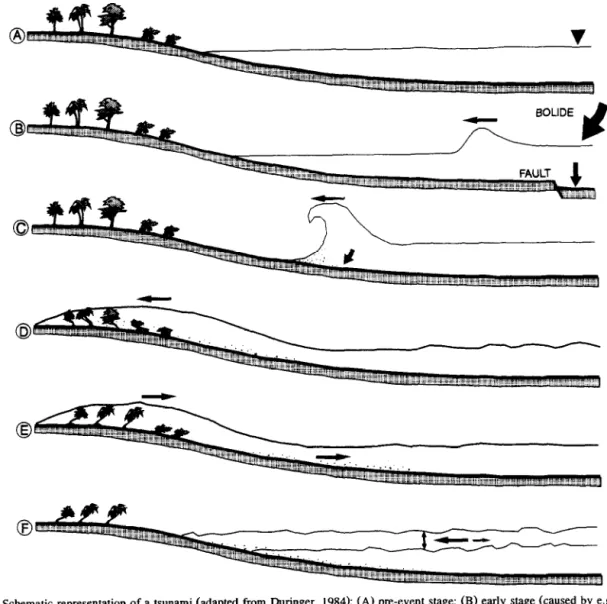SEDIMENTARY GEOLOGY
ELSEVIER Sedimentary Geology 104 ( 1996) 189-20 1
A possible tsunami deposit at the Cretaceous-Tertiary
boundary
in Pemambuco, northeastern Brazil
Gilbert0 A. Albert50 a, Paul0 P. Martins Jr. b
a PETRO BRA’S, Au. Elias Agostinho, 6% Pontu da Imbetiba, 27.913- 350, M acai, RJ, Brazil
b Universidude Federal de Ouro Preto, Depto. de Geologia, Campus do M ot-w do Cruzeiro, 35.4~~000, Ouro Preto. M G, Brazil
Accepted 1 April 1995
Abstract
Interdisciplinary and integrated investigations of a stratigraphic succession spanning the Cretaceous-Tertiary (K-T) boundary in Pemambuco (the Poty Quarry section, near Recife), northeastern Brazil, provides direct evidence for the hypothesis of an extraterrestrial bolide impact event. Discussions on the exact position of the K-T boundary point to an impact event in the earliest Danian. One particular bed at the base of the Maria Farinha Formation shows sedimentary characteristics and exotic (probably impact-derived) material which suggest the action of a tsunami wave. The distribution of iridium concentrations throughout the studied succession records a major peak of iridium (up to 69 times the background levels) at about 15-20 cm above the main tsunami bed.
1. Introduction
Alvarez et al. (1980) claimed that the biotic mass extinction which took place around the Cretaceous- Tertiary (K-T) boundary was triggered by the im- pact of an asteroid. The evidence includes the anomalous enrichment of rare chemical elements (in particular iridium), right at the K-T boundary of sedimentary successions in Italy, Denmark and New Zealand.
More recent research (Smit, 1990; Hildebrand et al., 1991; Alvarez et al., 1992) point to peculiarities present in the boundary bed of different places all over the globe, besides the iridium anomaly: shocked quartz, microspherules, microtektites, soot, and the identification of tsunamites and impact craters, all of them related to the K-T boundary.
Preliminary investigation of a stratigraphic suc- cession spanning the K-T boundary in Pemambuco
(the Poty Quarry section, near Recife, and Ponta do Funil area, near the state boundary between Pemam- buco and Paraiba), northeastern Brazil (Fig. l), pro- vide direct evidence for the hypothesis of an ex- traterrestrial bolide impact event (AlbertZo, 1993). This is an occurrence particularly interesting, be- cause it is the only K-T boundary reference section presently exposed in southern low-latitude regions, without evidence for a hiatus or reworking. The contact between the Gramame Formation and the Maria Farinha Formation is marked by a bed (bed D)
interpreted as a tsunami deposit.
The studied area is part of the Pemambuco- Paraiia Basin, a passive-margin rift basin of which the origin is related to the South Atlantic Ocean opening. The studied sedimentary succession was deposited during Maastrichtian and Danian ages and characterizes a marine regressive megasequence, as defined by Chang et al. (1988).
190 GA. Albert&, P.P. M artins Jr./Sedimentary Geology 104 (19961 189- 201
- Ponta do Funil - Eeberibe Formation
- Maria Farinha Formation
Fig. I. Location map for the outcrops of Poty Quarry (a, UTM 9 152 000N/300 OOOE) and Ponta do Funil area (b, UTM 9 117 OOON/296 OOOE). Pemambuco. The two localities are about 30 km apart. Starting points for UTM coordinates: 10 Mm S of the Equator, and 0.5 Mm W from the meridian 39”W of Greenwich, respectively.
Previous detailed stratigraphic studies in the Poty Quarry section have been carried out by Beurlen (1967a, b), Tinoco (1967, 197 1, 1976), Mabesoone (1967), Mabesoone et al. (1968), Stinnesbeck (1989), AlbertZio (1993) and AlbertZo et al. (1993).
2. Methods and data analyses
In general, detailed studies on complete sections including the K-T boundary are not available for Brazilian sedimentary basins. However, some out- crop data and drilling results (AlbertZo, 1993) pro- vided by PETROBRAS (Petroleo Brasileiro S.A., the State Oil Co. of Brazil) could be used to identify and further study this significant boundary. In this text, some outcrops from the Pemambuco-Parafba Basin (Olinda Sub-Basin) are described.
Besides field investigations, different samples col- lected from various outcrops were analyzed using the
following methods: (i) petrographic analysis; (ii) mi- cropalaeontological analysis (planktonic foraminifera and palynomorphs); (iii) X-ray diffractometry analy- sis (XRD); (iv) stable isotope analysis (carbon and oxygen), insoluble residue (IR) and total organic carbon (TOC) analysis; (v) instrumental neutronic activation analysis (INAA), which provided concen- trations for 46 chemical elements, including iridium (performed by the Los Alamos National Laboratory team, USA).
3. Stratigraphy and depositional environment
Outcrops studied in the Pemambuco-Parafba Basin, especially those in the Poty Quarry, near Recife, and Ponta do Funil area, near Goiana (both in the State of Pemambuco), show the following sequence (from bottom to top): the Gramame Forma- tion (marly biomicrites of deep neritic-upper bathyal
G.A. Albertiio, P.P. M artins Jr./Sedimentary Geology 104 (1996) 189- 201 191
20
10
P O- CM
4lW LEVEL - 58 _-_-__
3RD LEVEL
- 56
-______--__ - ss 3RD. LEVEL _---
- 54 2ND. LEVEL
-D
-2 1285CM .L
- 26
---
w
I I _L
BA SEO FTHEF’O TYQ UA RRY 882,5CM j.
_ lN CRWS,N G OF THE CACol CCN t EW
192 G.A. Albert&~, P.P. M artins Jr./Sedimentary Geology 104 (1996) 189- 201
environment) is overlain by the Maria Farinha For- mation. The latter consists of alternations between limestones (biomicrites, biosparites and calcilutites) and shales deposited in a middle-deep neritic envi- ronment. There is an erosive lithologic contact be- tween these two formations (Fig. 2). The sedimen- tary structures present at the transition from the
uppermost Gramame Formation to the basal portions of the Maria Farinha Formation (hummocky cross stratification, Fig. 3A, fining-upward and wavy bed- ding) characterize a carbonate ramp controlled by storms in a process of progressive marine regression (interpretation buttressed up by the ichnofossil, geo- chemical, palaeontological and mineralogical data; Albert”ao, 1993).
4. K-T boundary: peculiarities
A series of fourteen beds (named A to N from the base to the top of the succession) associated to a sequence of geological events was described in de- tail. The base of the Maria Farinha Formation, par- ticularly bed D (the first bed of the Maria Farinha succession; Fig. 4), is here interpreted as a sedimen- tary deposit formed through a process of higher energy than the other beds.
The K-T boundary was initially defined (Albertlao and Martins, 1992; AlbertSo, 1993; Albert50 et al., 1993) as a thin (2 cm) and continuous marly/shaly bed which is found only in the Poty Quarry (bed I;
Fig. 4). The boundary was defined through mi-
cropalaeontological analysis (palynomorphs and
foraminifera) where the major biotic extinctions oc- cur. Palynomorphs characterize the end of the Creta- ceous with extinctions of many species of Dinogym- nium, Cricotriporites almadaensis and Ariadnaes- porites sp., while the beginning of the Tertiary shows
the appearance of many pollens/spores such as
Echitriporites trianguliformis, Schizeoisporites eocenicus, Proxapertites cursus and palms. Foramin-
GA. AlbertZo, P.P. Martins Jr./Sedimentary Geology 104 (1996) 189-201 193
era characterize the end of the Cretaceous with the
disappearance of species such as Rugoglobigerina
ex gr. rugosa, Contusotruncana contusa, Pseu-
doguembelina costulata etc., while the beginning of
the Tertiary shows the continuity of Guembelitria
cretacea as well as the appearance of Eoglobigerina
edita and Parvularugoglobigen’na eugubina, among
others (Fig. 4).
At the same level where a biotic crisis is recorded, the geochemical analysis shows relevant iridium (Ir) and total organic carbon (TOC) anomalies. An Ir- anomaly (0.69 ppb) is identified in bed I (Fig. 4), in
conditions very similar to other sections around the world (Donovan et al., 1988; Bourgeois et al., 1988; Baadsgaard et al., 1988; Johnson et al., 1989; Schmitz, 1992; AlbertZo, 1993). The anomaly is almost 26 times greater than the mean value of the other samples collected in the studied area. High Ir concentrations may be artificially induced by an increase of the clay content in the deposit. However,
the ratios Ir/Fe, Ir/Al (geochemical data) and
Ir/clay (clay content obtained by XRD) confirm the anomaly (Figs. 5A, 5B)
Bed I also records an anomalous value of TOC
C -Clay FS - Fine sand
ST Slit MS - Mlddle sand
CS Coarse rand
- Sampler Colclrlltlte/calclrudlte Blomlcrlte(calclrudlte/
colcarenlte)
Morly/rhaly beds
Nodular wackertonel
packstone
Marlstone
Bloturbotlon
Fig. 4. Litho- and chemostratigraphy (iridium) and distribution of microfossils across the measured K-T boundary section in the Poty Quarry. Note the iridium anomaly in a 2-3 cm thick claystone (bed I) in the lower Danian (planktonic foraminifera zone upper P.a).
Planktonic Foraminifera (analysis by Dr. Eduardo A. M. Koutsoukos): (1) Woodringina hornestownensis; (2) Guembelitria cretacea; (3) Parasubbotina pseudobulloides; (4) W. claytonensis; (5) P. aff. pseudobulloides; (6) Eoglobigerina eobulloides; (7) Praemurica taurica; (8) Paroularugoglobigerina eugubina; (9) Pseudotextularia nuttalli; (IO) Pseudoguembelina costulata; (11) P. palpebra; (I 2) Rugoglo- bigerina ex gr. rugosa; ( 13) R. scotti; ( 14) Contusotruncana contusa; ( 15) R. reicheli; (16) Globotruncana aegyptiaca; ( 17) Racemiguem- belina fkcticosa; (18) Globotruncana falsocalcarata. Palynomorphs (analysis by Dra. Marilia S. P. Regali): (1) Proxapertites cursus; (2) Pterospermopsis sp.; (3) Veryhachium reductum; (4) Schizeoisporites eocenicus; (5) Echitriporites trianguliformis; (6) Ariadnaesporites
194 GA. Albertiio, P.P. Martins Jr./Sedimentary Geology 104 (I996) 189-2OI
1045
3
1025 +’
*?
+ .
1005 +z S I k 0
985
I
%5
945
925
9059
0.00 0.02 0.04 0.06 0.08 0.10 0.12
A
RATlOSxlO*+ -h/Al ??-k/Fe
1045
1 1025 +
+ + loos-
E 9a5-
E %5- +
x 945- +++ +
925- +v
905 1 I
0.00 0.01 0.02 0.03 0.04 0.05 0.06 0.07
1045 1 +
1025 I 1005- + z _+ + S gas-
E %5-
x 945-
925-
(Ir/clay)x 10-T
. ? ? ? ? . . + ? ? ?? ??? ? ? ? ?? ? ? .* . ??? ? ? ? ? ? ? ?
i+++: ??? ? ? ? ? ?
?? ? ? ?? ? ?
? ? ? ? ? ? ? ?? ?
9051 1 I s 1 1 I I I . . I I 1
0.01 0.03 0.05 0.07 0.09 0.11
C
t-TOC(%)1 I I I I -
O 10 20 30 40
H-In(%)
which may reflect high carbon concentration related to the presence of soot. The TOC anomaly is sup- ported by its independence in relation to the insolu- ble residue content in the analyzed samples (Fig. 50
Microtektite-like microspherules and shattered
fragments of shock-metamorphosed quartz grains are common to relatively frequent in the residues from beds near the K-T boundary, and are very rare in the subsequent lower boundary beds (Koutsoukos, 1994). Nearly 100 microspherules were picked and are cur- rently being studied for their morphological charac- teristics and geochemistry (Koutsoukos, in prep.). The microspherules range from 80 to 160 pm in diameter and are spherical or teardrop in shape; their appearance is similar to that of known tektites and microtektites (Fig. 6A). The shattered shocked quartz grains are relatively rare and present microscopic planar features (Fig. 6B).
5. Discussion on the K-T boundary position
The micropalaeontological evidence reveals a pe-
riod of crisis at the K-T boundary clay (bed I; Fig. 4), with the extinction datum of nearly all the latest Maastrichtian planktonic foraminifera, and of many
groups of dinoflagellates, pollens and spores
(Albert”ao, 1993). The coeval stratigraphic record of the TOC and iridium anomalies, common shattered fragments of shock-metamorphosed quartz grains and microtektite-like microspherules, with the mass bi- otic extinction datum, in bed I, give strength to the definition of the K-T boundary in the Poty Quarry section. Furthermore, it provides direct evidence that supports an extraterrestrial bolide-impact origin for the terminal Cretaceous event and the related bound- ary beds.
GA. Albert& P.P. Martins Jr./Sedimentary Geology 104 (1996) 189-201 195
Nevertheless, Koutsoukos (1994) and Albert’io et al. (1994) observed the first occurrence of Danian taxa of planktonic foraminifera and even of micro- spherules and shocked quartz in bed C (Fig. 4). For this reason, the K-T boundary is here considered between beds B and C instead of bed I.
At just one portion of the Poty Quarry very rare burrows were observed in bed D (burrows which were probably formed after the event responsible for the deposition of bed D). One could take into ac- count the possibility that bioturbation across these beds may have mixed microfossils of different ages. This possibility will be investigated in a future field work because there was no apparent sign of bioturba- tion in the parts which were sampled.
6. Bed D
Bed D, a 50-cm-thick bioclastic/intraclastic packstone (Fig. 3B), resembles the ‘graded skeletal sheet’ facies of Aigner (1985), although the coarse texture prevents the preservation of fine sedimentary structures. Bed D marks the lowermost boundary of the Maria Farinha Formation, which shows unique stratigraphic and sedimentological characteristics in- dicating rapid deposition: (i) a sharp erosive base (Fig. 3C), followed by (ii) a fining-upward succes- sion composed of shells, siliciclasts and abundant phosphatized fragments at the base (Figs. 3C and 7A), (iii) extensive mixing and fragmentation of fossils derived from different palaeodepths and re- worked from older strata (Figs. 3B and 7B1, (iv) coarse grain-size (intraclasts and bioclasts of up to 9 cm in diameter were found) and poor sorting (Fig. 7B1, (v> scattered impact-derived products (micro-
tektite-like microspherules and shock-metamor-
phosed quartz grains; Figs. 6A and 6B1, (vi> interfer- ence ripples at the top of the bed (Fig. 7C), and (vii) great lateral continuity in the basin (for at least 30 km in Pemambuco). The great lateral continuity of bed D is one of its most conspicuous characteristics because it is possible to follow this bed from the Poty Quarry to the Ponta do Funil area (Fig. 1). Between these areas, in the Itamaraca island, a core was recovered from well 2-Ist-I-PE, drilled by PETROBRAS. This core also exhibits the presence
of bed D.
Bed D is overlain by alternating beds of fine- grained limestones (beds F and H) and marlstones (beds E, G and I; see Fig. 4) which indicate a progressive reduction of the depositional energy. Im-
pact-derived material (abundant shock-metamor-
phosed quartz grains, with several sets of intersecting deformation lamellae, and microtektite-like micro- spherules) also occur in beds C to I (Fig. 4) but have not been found below bed C. In addition, bed I exhibits Ir and TOC anomalies.
7. Semi-quantitative modelling
The sedimentary records given above, such as the mixture of fossils (derived from different environ-
ments-deeper and shallower, and also reworked
from older strata) and the presence of coarse silici- elastic grains indicate that a high-energy mechanism played a role in the deposition of bed D.
Bourgeois et al. (1988) suggest that coarse-grained sedimentary deposits at or close to the K-T bound- ary may be related to a huge tsunami wave generated by a meteorite impact. The occurrence of tsunami beds or deposits related to convulsive geological events have been reported recently from sections in Braggs and Brazos River (Bourgeois et al., 1988), Haiti (Florentin et al., 19911, Mexico (Smit et al., 19921, Cuba (Iturralde-Vinent, 19921, and in DSDP @)I);; Sea Drill ing Project) sites (Alvarez et al.,
A semi-quantitative modelling on the hypothesis of the depositional processes active during that boundary event indicates that, most likely, a major tsunami wave formed bed D. The methods described by Bourgeois et al. (1988) and the mechanism indi- cated by Duringer (1985; see Fig. 8) were applied for the calculation of such a process. The dimension of the giant wave which was responsible for the deposi- tion of bed D was estimated, assuming for the Per- nambuco K-T boundary succession the same condi- tions as considered for the Brazos River.
The following observations were also taken into account (Table 1):
(1) The micropalaeontological data based on
G.A. Albertrlo, P.P. Martins Jr./Sedimentary Geology 104 (1996) 189-201 197
Table 1
Semi-quantitative modelhng based on the characteristics of bed D
ESTIMATED PALEODEPfH ( I ) LARGEST CLASTS ( II ) WAVE-LENGTHS (ABGVE LAYER D)
50-2OOm (1OOm) 2-9 (5cm) (IQ
15-20~~1 (15cm)
I+rI~u*REQulRED I + II + U* * WAVE HEIGHTiVELGCIT?‘/LENGTH III -REDUCTION OF U*
15cm/s > 20m I 112knVh / 112km lJcm/S~lcnVS
Table 2
Estimation of shear velocities vs. wave heights (Bourgeois et al., 1988): T (mm) Shear velocity (cm/s) for wave heights of
2m Water depth = 50 m
8 _
12 2.1
16 2.7
20 2.9
Water depth = 100 m
8 _
12
16 1.4
20 1.8
4m 6m 8m 10 m 15m 20m
1.4 1.9 2.4 + + +
3.8 5.4 7.0 8.5 12.1
4.9 6.9 8.9 10.9 * (15.5) (L.0)
5.3 7.6 9.8 (I 1.9) (17.0) (21.9)
+ +
1.2 1.7 2.3 2.7 3.3 4.9
2.5 3.5 4.5 * (7.9) (10.1)
3.2 4.5 5.9 (:::) (10.2) (13.1)
_= subcritical (no transport). + = wave too steep, will collapse. * = maximum recorded wave.
Parentheses indicate extreme wave conditions.
tion based on autochthonous benthic foraminifera recovered from hemipelagic clay bed I; AlbertZo,
1993).
(2) The biggest clasts in bed D have diameters from 2 to 9 cm. The value of km was used in the calculations, which is the same value used by Bour- geois et al. (1988).
(3) The wavy bedding structures of beds E, F, G and H (Fig. 7C) indicate wave-lengths which range
from 15 to 20 cm. It was used again the same value of Bourgeois et al. (1988): 15 cm.
(4) The exclusive action of eustatic sea-level fluc- tuations would not be enough to create structures such as fining-upward and wavy bedding.
(5) Turbidity currents would produce strongly asymmetrical ondulations (e.g. current ripples).
(6) Even the strongest storm would not have been able to generate waves to move the large clasts
198 GA. Albert&, P.P. Murtins Jr./Sedimentary Geology 104 (1996) 189-201
Fig. 7. (A) Detail of bed D presenting fining-upward grain-size distribution. The top of the sequence is bed H, which marks the limit between the first two levels of the Poty Quarry. (B) Block of bed D (Poty Quarry) with its characteristic heterogeneous compo- sition (phosphatized fragments P, fragments of gastropods G and pclecypods PL., siliciclasts S, intraclasts I) and coarse grain size. (C) Detail of bed D, Poty Quarry, with wavy bedding structure in bcdsE,FandG.
which occur in bed D, deposited at palaeodepths of 100 to 200 m. Besides that, hummocky cross-stratifi- cation was not observed in the outcrops of bed D.
This structure occurs below bed D in the Ponta do Funil area.
According to Bourgeois et al. (1988) shear veloci- ties (CI * > of at least 15 cm/s would be needed to erode and transport clasts of about 5 cm in diameter; U * of 15 cm/s at water depths of more than 100 m requires waves higher than 20 m (Table 2). Based on the wave height it is also possible to estimate its velocity (C = 112 km/h) and length (L = 112 km); such waves are associated with major tsunami pro- cesses.
Furthermore, the wave-lengths of sedimentary structures in beds E, F, G and H (15 to 20 cm) indicate U * of only 1 cm/s (using the same princi- ples as Bourgeois et al., 1988). Therefore, a reduc- tion of U * from at least 15 cm/s (at the base of bed
D) to 1 cm/s (beds which overlie bed D) is required. Such a reduction of shear velocities is commonly attributed to tsunami processes in platform settings. Beds E, F, G and H present wave bedding out-of- phase, which also corroborates the reduction of ve- locity toward the top of bed D (Table 1). These fine-grained graded beds could have been deposited by multiple attenuated waves or through wave reflec- tion, known from shelf settings (Duringer, 1984; Bourgeois et al., 1988). Probable impact-derived ma-
terial, such as iridium, microtektite-like micro-
spherules and shattered shock-metamorphosed quartz grains are concentrated in the more slowly deposited hemipelagic bed I. Bed H and particularly bed I are
bioturbated, which indicates some break in sediment accumulation.
8. Conclusions
GA. Albertiio, P.P. M artins Jr./ SC xfimentary Geology 104 (1996) 189- 201 199
ica) and of TOC, impact-derived exotic products
(such as microtektite-like microspherules and
shock-metamorphosed quartz grains), and a possible impact-generated tsunamite.
If the K-T boundary really occurs in between beds B and C, the tsunami beds may be related to an early Danian bolide impact in the northern South Atlantic area. All that seems to be similar to the apparently coeval tsunami beds in Texas (Mont-
gomery et al,, 1992), and in the Caribbean areas (Florentin et al., 1991). In these regions the geologic record at the K-T boundary was strongly disturbed. However, if stratification was affected by biotur- bation and the K-T boundary is represented by bed
I, two hypotheses may be taken into account, consid- ering the conspicuous lateral continuity of bed D and an oceanic gateway between the early Gulf of Mex- ico and the northern portion of the South Atlantic
200 GA. AlbertEo. P.P. Martins Jr. / Sedimentary Geology 104 (1996) 189-201
(Koutsoukos, 1992): (i) a close coeval and genetic relationship between Yucat5n impact at the K-T boundary (the Chicxulub Crater; Hildebrand, 1991) and the impact-generated tsunami deposits found in Texas, the Caribbean, and bed D in Pemambuco, and (ii) the relationship of bed D with other probable impact(s) which may have happened somewhere in the South Atlantic, simultaneously with that of the Yucat&n Peninsula.
Acknowledgements
The authors wish to thank Dr. Jorge C. Della
Favera (State University of Rio de Janeiro) and the institutions PETROBRAS, Universidade Federal de Ouro Preto, Los Alamos National Laboratory, Cia. de Cimento Votorantim (Pedreira Poty), and Univer- sidade Federal de Pemambuco for their support in this research; Dr. Eduardo A. M. Koutsoukos (PET- ROBRAS) for discussions, foraminera analysis and photographs which are included i? Fig. 6, and Dra. Marilia S.P. Regali (PETROBRAS) for the paly- nomorphs analysis; and also Drs. T. Shiki, G. Ein- sele and C.H.L. Bruhn for various suggestions.
References
Aigner, T., 1985. Storm Depositional Systems: Dynamic Stratigra- phy in Modem and Ancient Shallow Marine Sequences. Lec- ture Notes in Earth Sciences, 3. Springer-Verlag. Berlin, 174
PP.
Albert’ao, G.A., 1993. Abordagem interdisciplinar e epistemol6gica sobre as evid&ncias do limite Creticeo-Tercitio, corn base em leituras efetuadas no registro sedimentar das Bacias da Costa Leste Brasileira. M.Sc. Thesis, Federal University of Ouro Preto, 2 volumes, 251 pp.
Albert%o, G.A. and Martins, P.P., Jr., 1992. 0 limite Creticeo- Terci&io nas Bacias Sedimentares da Costa Leste Brasileira. 35th Congr. Geol. Brazil, pp. 463-465 (abstr.).
AlbertZo, G.A., Koutsoukos, E.A.M., Regali, M.S.P., Attrep, M., Jr. and Martins, P.P., Jr., 1993. The Cretaceous-Tertiary boundary record in Eastern Marginal Sedimentary Basins of Brazil. Acta Geol. Leopoldensia, XVI: 59-7 1.
Albertso, G.A., Koutsoukos, E.A.M., Regali, M.S.P., Attrep, M., Jr. and Martins, P.P., Jr., 1994. The Cretaceous-Tertiary boundary in Southern low-latitude regions: preliminary study in Pemambuco, Northeastern Brazil. Terra Nova, 6: 366-375. Alvarez, L.W., Alvarez, W., Asaro, F. and Michel, H.V., 1980.
Extraterrestrial cause for the Cretaceous-Tertiary extinction. Science, 208: 1095- 1108.
Alvarez, W., Smit, J., Lowrie, W., Asaro, F., Margolis, S.V., Claeys, P., Kastner, M. and Hildebrand, A.R., 1992. Proximal impact deposits at the K-T boundary in the Gulf of Mexico: a restudy of DSDP leg 77 sites 536 and 540. Geology, 20: 697-700.
Baadsgaard, H., Lerbekmo, J.F. and MacDougall, I., 1988. A radiometric age for the Cretaceous-Tertiary boundary based upon K-Ar, Rb-Sr, and U-Pb ages of bentonites from Al- berta, Saskatchewan, and Montana. Can. J. Earth Sci., 25:
1088-1097.
Beurlen, K., 1967a. Estratigrafia da faixa sedimentar costeira Recife-Jdo Pessoa. Bol. SBG, 16: 43-53.
Beurlen, K., 1967%. Paleontologia da faixa costeira Recife-JoHo Pessoa. Bol. SBG, 16: 73-79.
Bourgeois, J., Hansen, T.A., W&erg, P.L. and Kauffman, E.G., 1988. A tsunami deposit at the Cretaceous-Tertiary boundary in Texas. Science, 241: 567-570.
Chang, H.K., Kowsmann, R.O. and Figueiredo, A.M.F., 1988. New concepts on the development of East Brazilian Marginal Basins. Episodes, 11: 194-202.
Donovan, A.D., Baum, G.R., Blechschmidf G.L., Loutit, T.S., Pflum, C.E. and Vail, P.R., 1988. Sequence stratigraphic setting of the Cretaceous-Tertiary boundary in Central Al- abama. In: C.K. Wilgus, H. Posamentier, B.S. Hastings, J. Van Wagoner, C.A. Ross and C.G.St.C. Kendall (Editors), Sea-Level Changes: An Integrated Approach. SEPM, Spec. Publ., 42: 299-307.
Duringer, P., 1984. TempCtes et tsunamis: des dtpats de vagues de haute tnergie intermittente darts le Muschelkalk sup&eur (Trias germanique) de I’Est de la France. Bull. Sot. GCol. Fr., XXVI: 1177-1185.
Florentin, J.-M., Maurrasse, R. and Sen, G., 1991. Impacts, tsunamis, and the Haitian Cretaceous-Tertiary boundary bed. Science, 252: 1690- 1693.
Hildebrand, A.R., Penfield, G.T., Kring, D.A., Pilkington, M., Camargo, A., Jacobson, S.B. and Boynton, W.V., 1991. Chicxulub crater: a possible Cretaceous/Tertiary boundary impact crater on the Yucat&n Peninsula, Mexico. Geology, 19: 867-871.
Iturralde-Vinent. M.A., 1992. A short note on the Cuban late Maastrichtian megaturbidite (an impact-derived deposit?). Earth Planet. Sci. Lett., 109: 225-228.
Johnson, K.R., Nichols, D.J., Attrep, M. and Orth, C.J., Jr., 1989. High-resolution leaf-fossil record spanning the Cretaceous/ Tertiary boundary. Nature, 340: 708-710.
Koutsoukos, E.A.M., 1992. Late Aptian to Maastrichtian foraminiferal biogeography and palaeoceanography of the Sergipe Basin, Brazil. Palaeogeogr., Palaeoclimatol., Palaececol., 92: 295-324.
Koutsoukos, E.A.M., 1994. The Cretaceous-Tertiary boundary in Pemambuco, Northeastern Brazil. 2nd Colloquium of Stratig- raphy and Paleogeography of the South Atlantic, Angers, pp. 81-82 (abstr.).
Mabesoone, J.M., 1967. Scdimentologia da faixa costeira Recife- Joso Pessoa. Bol. SBG, 16: 57-72.
GA. Alberrtio, P.P. M artins Jr. /Sedimentary Geology 104 (I 996) 189- 201 201
Montgomery, H., Pesagno, E., Soegaard, K., Smith, C., Muiios, I. and Pessagno, J., 1992. Misconceptions concerning the Creta- ceous/Tertiary boundary at the Brazes River, Falls County, Texas, Earth Planet. Sci. Lett., 109: 593-600.
Schmitz, B., 1992. Calcophile elements and Ir in continental Cretaceous-Tertiary boundary clays from the western interior of the USA. Geochim. Cosmochim. Acta, 56: 1695- 1703. Smit, J., 1990. Meteorite impact, extinctions and the Cretaceous-
Tertiary boundary. Geol. Mijnbouw, 69: 187-204.
Smit, J., Montanari, A., Swinbume, N.H.M., Alvarez, W., Hilde- brand, A.R., Margolis, S.V., Claeys, P., Lowrie, W. and Asaro, F., 1992. Tektite-bearing, deep-water elastic unit at the Cretaceous-Tertiary boundary in northeastern Mexico. Geol- ogy, 20: 99-103.
Stimresbeck, W., 1989. Fauna y microflora en el limite Cretacico-Terciario en el Estado de Pemambuco, Noreste de Brasil. Contribuciones de 10s Simposios sobre Cretkico de America Latina, Parte A: Eventos y Registro Sedimentario, pp. 215-230.
Tinoco, I.M., 1%7. Micropaleontologia da faixa sedimentar costeira Recife-Jogo Pessoa. Bol. SBG, 16: 81-85.
Tmoco, I.M., 1971. Foraminiferos e a passagem en&e o Crettkeo e o Terciario em Pemambuco. Ph.D. ‘lhesis. University of SIo Paulo, SZo Paulo, 132 pp. (unpubl.).
